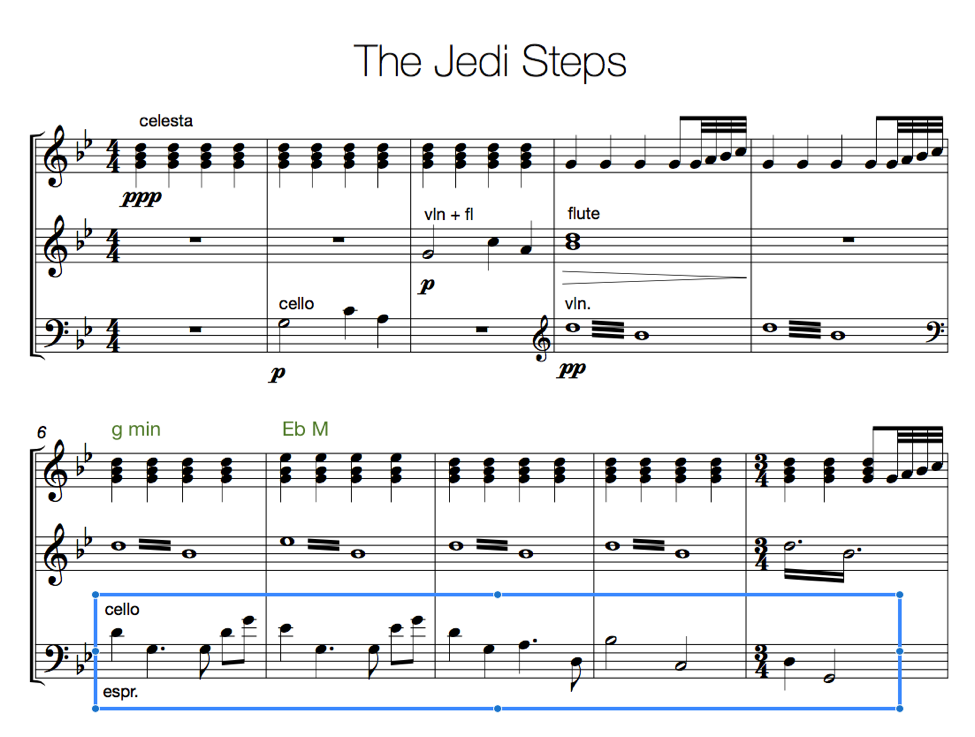Ambiguity in the sides of the Force
Analyzing the music for “The Jedi Steps” in Star Wars: The Force Awakens
**This post contains SPOILERS**
The Dark and the Light sides of the Force in the latest Star Wars movie are not as clearly delineated as they were before. Luke is gone searching for the primal Temple of the Force, where, it is said, both sides of the Force cohabited. In fact, the whole movie presents a vision of the force that intends to generate an overall grey area between both sides. This shouldn’t be surprising, as being a Jedi is, at least, morally hard for a human being. As Yoda explains to Anakin in Episode III:
YODA: Death is a natural part of life. Rejoice for those around you who transform into the Force. Mourn them, do not. Miss them, do not. Attachment leads to jealousy. The shadow of greed, that is.ANAKIN: What must I do, Master Yoda?YODA: Train yourself to let go of everything you fear to lose.
In fact, not letting go “everything you fear to lose” is what made Luke go to Bespin in the Empire Strikes Back instead of finishing his training with Yoda. In certain ways, with Luke, a new deinstitutionalized version of the Jedi order began. In the Force Awakens, we do not know much about his intention to create a Jedi Academy more than that it failed when Leia and Han’s son turned to the Dark Side. Thus, we do not know how Luke approached the training of the Force. However, we do know that he disappeared in the search of this temple in which dark and light sides does not matter.In this post I am going to just talk about a very specific element of the movie: the music that sounds when Rey arrives to Luke’s planet and climbs the stairs (The JEDI STEPS in the soundtrack [https://www.youtube.com/watch?v=cUBUlKgsNK8]). The theme is an evolution of the May the force be with you theme, one of the most iconic themes of the saga. Let’s take a look at the beginning:
The opening interval is an inversion of the May the Force theme:
The differences between both themes are key. As I just mentioned, the opening interval in the new theme descends, at the same time that the accent is also inverted. In the original theme, the accent is on the second note of the interval, whereas in this new theme it is on the first note. The original theme suggests nostalgia with hope (thanks to the ascending line and to the C Major chord on the last measure). Instead, this new theme suggests confusion and some sort of sadness. The line is descending generally, only ascending to present the Eb M chord in its second measure - as if this moment of happiness was just a ghost from the past. This is because it seems clear that having the “Force with you” is not enough in order to find a balanced life. Moreover, there is a contradiction between what it is required to become a Jedi (a sort of celibacy) and most natural human instincts (fear, love, attachment). Before going deeper into that point, let’s take a look to the second element of the theme:
Interestingly, this seems to be derived from the Luke and Leia theme. In the following excerpt, I divided the note values in half to facilitate the comparison:
This relationship between both themes might suggest that either Luke or Leia are Rey’s father or mother. More importantly, it also connects this new theme with a fundamental issue with Luke and Leia’s relationship with the Force. Their connection (they are twins) makes them both “strong in the Force” and unable to “let go of everything you fear to lose”. Their love as brother and sister makes them unable to not fear each other’s lost. Perhaps, finding a balance between both sides is the only hope for the disgraced Skywalker family and, as it seems, for the whole galaxy.
The theme repeats in the flute to then break for a moment (measure 16 [1:00]):
Measure 16 and 17 are a clear reference to the Imperial March, which regularly serves as the Darth Vader's theme:
This connection adds even more ambiguity to this new theme. Even though the theme should be focused on Rey’s Steps to becoming a Jedi (it is presented when she is symbolically climbing the steps to reach Luke and maybe to a Jedi Temple), it also serves to portray the complicated history of the Skywalkers, in which dark and light side are intimately connected. This is why I didn’t see the movie as the beginning of another story of redemption as it was for Darth Vader in the original trilogy, but a story about how to integrate a complex reality in order to find the balance. The theme continues (measure 18) with a solo Horn in a forte dynamic crescendo. The nature of the French horn in the lower register (compared to the cellos) increases the intensity and the darkness of the theme, as the lower notes sound profound but unclear. It is also the instrument used to start the May the Force theme that follows. This is when Rey sees Luke:
However, the May the Force theme blends with the new theme in measure 32 [1:37]. At this moment, the material for the new theme is transformed by the May the Force thematic elements into a rising line that concludes the movie. What does this final ascending line mean, especially if the new theme was precisely a descending line? The answer might have to wait a couple of years until Episode VIII is released.







